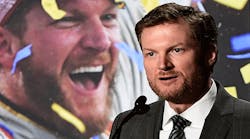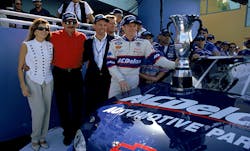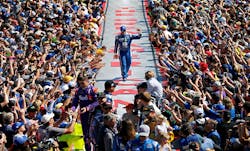Dale Earnhardt Jr. is in the prime of his career and a 26-time race winner on NASCAR’s top circuit, including two Daytona 500 victories. Many drivers have raced well into their 50s, but few have matched the overall career success of the 42-year-old Dale Jr.
In 2016, despite being injured for much of the season, he earned over $23 million, more than any other driver. He has been voted NASCAR’s most-popular driver 14 times and once even had a rock band named after him (Dale Earnhardt, Jr. Jr. k/n/a Jr. Jr.).
So, why walk away from the sport now, at this young age, when he’s on top of NASCAR? The answer is simple: workplace safety.
Dale Jr.’s Concern About Safety
During his April 25 press conference, Dale Jr. stated that his recent concussions, the latest suffered during the 2016 season, led to his decision to retire. He said he wanted to “leave on his own terms.” Dale Jr. was concerned that a future injury may not only end his career but permanently impact his health if he remained in a race car.
In an interview regarding his concussions, he told NPR’s Lulu Garcia-Navarro: “You can never be safe enough. I mean, we’ve learned a lot of things in the past 20 years, made a lot of updates to the race tracks. Soft walls on all the race tracks is mandatory now. . . . I’m excited about what I’m seeing out of NASCAR being more proactive to keep drivers safe and err on the side of safety.”
Dale Jr. likely first began worrying about his safety as a driver when his iconic father sadly was killed in an on-track wreck during the 2001 Daytona 500.
Death of Dale Earnhardt Sr.
Dale Jr. and his late father Dale Earnhardt, Sr. are NASCAR racing legends. To understand the significance of Dale Jr.’s retirement from NASCAR, one must comprehend the popularity of his family in the sport. Simply put, the Earnhardts are the first family of NASCAR.
They have enjoyed a cult-like following in the Southeastern United States for decades. As a native of Bristol, Tenn., and season ticket holder at Bristol Motor Speedway (the World’s Fastest Half-Mile), I can attest to the unparalleled loyalty of the Earnhardt fan-base.
When Dale Sr. died tragically during the last laps of the 2001 Daytona 500, the response to Dale Sr.’s death was unlike anything I’d ever seen. Not only was Earnhardt merchandise – flags, posters and t-shirts – present everywhere in my hometown, grown men took bereavement leave from their jobs to mourn Dale Sr.’s death. One hardcore fan, a co-worker of my father, took two weeks of leave due to the loss of “Dale.” Bristol Motor Speedway even served as a makeshift memorial for the deceased legendary driver. Others in the South placed “#3” signs on their own car’s roof, as if another guardian had been added to the angel ranks.
The death of “#3” was devastating, not only due to the loss of an ultra-popular hard-charging racecar driver, but because the Southern culture of following NASCAR and watching their beloved Dale race every Sunday would never again be the same. Dale Sr.’s death was a big deal.
Safety Is Paramount
Dale Jr.’s retirement announcement was just as big as his father’s death for many NASCAR fans. Knowing that he is giving up the following of an incredibly loyal fan base and millions of dollars in advertisements and prize winnings, Dale Jr. genuinely must be concerned about his safety to walk away now (fellow NASCAR driver Carl Edwards, age 37, also recently retired due to safety concerns). This message and concern has transcended other sports, most notably the National Football League.
The message Dale Jr. (and Edwards) is sending is that nothing is more important that one’s health and safety, and no amount of money can force him to make his living driving a racecar up to 200 miles per hour.
Employers can learn from Dale Jr.’s abrupt retirement and his message about the importance of workplace safety. Here are a few lessons for employers to glean from the popular driver’s departure:
Money isn’t the best way to lure talent – Employers often make the mistake of using money as their primary recruitment tool. Although salary may have been the principal attractant in the past, Dale Jr.’s departure from his multi-million dollar (rock-star-like) job in favor of workplace safety is consistent with what employers are seeing with younger workers. Workers are looking for a safe workplace; they want to go home to their families every night. Unlike Dale Sr.’s generation, younger workers have access to safer work environments and won’t overlook poor safety practices just to remain loyal to their employer.
A poor safety culture leads to employee turnover – Dale Jr. likely never stopped thinking about his safety after his father died. It probably changed the way he drove a racecar and his thoughts about racing in general. He decided that he wouldn’t allow his dangerous job to impact his health.
Your employees are paying attention to safety issues. If workers see other employees suffer injuries or witness near-misses, it will impact their work practices, thoughts about your business and whether or not they will leave employment with you. A robust safety program will allow employees to feel comfortable at work, achieve their potential and encourage them to stay.
The time for change to your safety program is now – Don’t continue to have near-misses and accidents occur at your facility. Each day that goes by without change, the more likely it is that you will lose a talented employee due to safety concerns. No matter how small the task is – whether rewriting training documents or holding safety meetings with workers – each step brings you closer to your workplace safety goals.
Dale Jr. walked away from it all to remain safe. When determining how to improve your workplace, consider what drives your employees to remain loyal to your company. Lead with safety.
About the author: Travis Vance is of counsel in the Charlotte, N.C. office of Fisher Phillips. He also is a frequent contributor to the firm’s Workplace Safety and Health Law Blog. Vance counsels employers and owners on all aspects of employment law and the development of preventive policies and procedures to avoid employment and workplace safety and OSHA- related claims. He handles litigation in both federal and state courts and claims pending with state and federal agencies including the Equal Employment Opportunity Commission and the U.S. Department of Labor.


